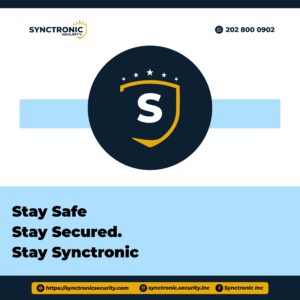.
.
How to Have Personal Security in Today’s Unpredictable World
In a world where uncertainty seems to grow by the day, personal security is no longer a luxury—it’s a necessity. From cyber threats to physical dangers, we all face risks every day. But the good news is: you have more control than you think.
At Synctronics Security, we believe that safety begins with awareness, discipline, and smart habits. Whether you live alone, run a business, or manage a household, this guide will help you take practical steps to protect yourself and those you love.
🔐 What is Personal Security?
Personal security refers to the measures you take to safeguard your life, belongings, identity, and peace of mind. It includes:
Physical protection (your body and environment)
Digital safety (your data and devices)
Emotional awareness (your reactions and instincts)
Having personal security means being proactive—not paranoid—and preparing for danger before it happens.
🚶♂️ 1. Stay Aware of Your Surroundings
One of the simplest yet most powerful habits is situational awareness. Criminals look for distracted, unaware people.
Avoid being glued to your phone when walking on the street.
Scan your environment: exits, people, unusual behavior.
Trust your instincts. If something feels off—it probably is.
🏠 2. Secure Your Home
Your home should be your safe haven. But many people leave it vulnerable.
Here’s how to boost your home security:
Install strong door locks, deadbolts, and window grills.
Use motion-sensor lights at night.
Set up a CCTV system that you can monitor remotely.
Don’t leave spare keys outside. Give them to a trusted neighbor instead.
Consider hiring professional security services, like those offered by Synctronics Security.
📲 3. Protect Your Digital Life
In today’s digital age, hackers and scammers are more dangerous than pickpockets.
Protect your data with these simple tips:
Use strong, unique passwords for every account.
Enable two-factor authentication (2FA).
Avoid using public Wi-Fi for banking or sensitive communication.
Regularly update your software and antivirus.
Be cautious about what you post on social media—don’t announce your location or travels publicly.
🚘 4. Practice Road Safety
Whether you’re walking, driving, or using public transport, safety on the road is key.
Lock your doors while driving.
Avoid isolated or poorly lit routes at night.
Don’t pick up strangers or accept random rides.
Always check your car before entering.
Be wary of staged accidents or suspicious roadside help.
🛍️ 5. Be Security-Smart in Public Spaces
Markets, malls, ATMs, restaurants—these are places where people get too comfortable and lose their guard.
Don’t flash cash, jewelry, or expensive gadgets.
Stay in well-lit, populated areas.
Use ATMs during the day and in secure locations.
Keep your bag in front of you, especially in crowds.
When in doubt, call someone or ask for assistance from known authorities.
🧠 6. Be Mentally Prepared
You don’t need to be paranoid, but mental readiness can save your life.
Take self-defense or first aid training.
Rehearse simple escape plans: “If someone grabs me, I’ll scream and run toward light.”
Have emergency contacts saved and memorized.
Learn how to detect lies, manipulative tactics, or grooming (especially important for children and teens).
👨👩👧 7. Protect Your Family
If you’re a parent or guardian, your personal security also includes your household.
Teach kids how to respond to strangers and emergencies.
Set boundaries for internet and phone use.
Keep emergency supplies (flashlight, water, medicine) ready at home.
Have a “safe word” for family emergencies.
📞 8. Know Who to Call
Don’t wait until it’s too late to know who to call in emergencies.
Save the numbers of police, ambulance, fire service, and a trusted neighbor.
Consider subscribing to a professional security service provider, like Synctronics Security, that offers emergency response.
🔧 Bonus: Partner with Professionals
Sometimes, DIY isn’t enough. For bigger protection needs, working with professionals gives you peace of mind.
At Synctronics Security, we offer:
Trained guards for residential and business use
Surveillance installations and monitoring
Quick-response units for emergencies
Security risk assessments for individuals and organizations.
👣 Final Steps: Build Personal Security Into Your Routine
Start small, stay consistent, and increase your efforts over time.
Here’s a simple weekly checklist:
Day Task
Monday Change passwords for key accounts
Tuesday Test home locks and CCTV
Wednesday Teach a child one safety habit
Thursday Scan your surroundings more often
Friday Inspect your car security
Saturday Back up your phone & update antivirus
Sunday Review emergency contacts & plan




Super https://shorturl.fm/6539m
Very good https://shorturl.fm/TbTre
Very good partnership https://shorturl.fm/68Y8V
Good https://shorturl.fm/j3kEj
Good https://shorturl.fm/j3kEj
Super https://shorturl.fm/6539m
Very good partnership https://shorturl.fm/68Y8V
Awesome https://shorturl.fm/A5ni8
Awesome
This is Educative. Please keep the blog going.